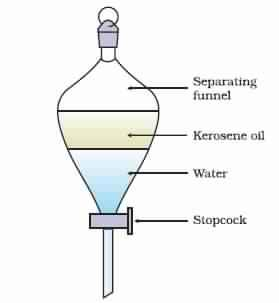
Separation of two immiscible liquids is based on:
(a) Difference in the solubility of the two liquids
(b) Difference in densities of the two liquids
(c) Difference in melting point of the two liquids
(d) Difference in boiling point of the two liquids
Answer
497.4k+ views
Hint: To answer this question, we must first clearly understand when and why are two liquids immiscible. We should also recall the concepts of separation of mixtures.
Complete step by step solution:
Immiscible liquids are those liquids which will not mix with each other to give a single phase. Oil and water are examples of immiscible liquids - one floats on top of the other. Though classified as immiscible, in actual fact, there is still some degree of mutual solubility. For example, in benzene and water, a small amount of benzene will be dissolved in the water phase, and vice versa.
Since by definition, immiscible liquids do not interact with each other in any way whatsoever, they will evaporate completely independent of each other.
For separating immiscible liquids like oil and water we use separating funnels.
The principle of separating funnels is that immiscible liquids separate out in layers depending on their densities.
Hence, the correct answer is Option (B) Difference in densities of the two liquids
Additional information:
We can separate a mixture of Kerosene oil and water in the following way.
1- Pour the mixture of kerosene oil and water in a separating funnel
2- Let it stand undisturbed for sometime so that separate layers of oil and water are formed.
3- Open the stopcock of the separating funnel and pour out the lower layer of water carefully.
4- Close the stopcock of the separating funnel as the oil reaches the stop-cock.

Note: This principle of separation of immiscible fluids on the basis of densities also finds application in the extraction of iron from its ore. The lighter kerosene oil is collected at the top of the separating funnel while heavier water will be pore out from the bottom.
Complete step by step solution:
Immiscible liquids are those liquids which will not mix with each other to give a single phase. Oil and water are examples of immiscible liquids - one floats on top of the other. Though classified as immiscible, in actual fact, there is still some degree of mutual solubility. For example, in benzene and water, a small amount of benzene will be dissolved in the water phase, and vice versa.
Since by definition, immiscible liquids do not interact with each other in any way whatsoever, they will evaporate completely independent of each other.
For separating immiscible liquids like oil and water we use separating funnels.
The principle of separating funnels is that immiscible liquids separate out in layers depending on their densities.
Hence, the correct answer is Option (B) Difference in densities of the two liquids
Additional information:
We can separate a mixture of Kerosene oil and water in the following way.
1- Pour the mixture of kerosene oil and water in a separating funnel
2- Let it stand undisturbed for sometime so that separate layers of oil and water are formed.
3- Open the stopcock of the separating funnel and pour out the lower layer of water carefully.
4- Close the stopcock of the separating funnel as the oil reaches the stop-cock.

Note: This principle of separation of immiscible fluids on the basis of densities also finds application in the extraction of iron from its ore. The lighter kerosene oil is collected at the top of the separating funnel while heavier water will be pore out from the bottom.
Recently Updated Pages
Master Class 11 Economics: Engaging Questions & Answers for Success

Master Class 11 Business Studies: Engaging Questions & Answers for Success

Master Class 11 Accountancy: Engaging Questions & Answers for Success

The correct geometry and hybridization for XeF4 are class 11 chemistry CBSE

Water softening by Clarks process uses ACalcium bicarbonate class 11 chemistry CBSE

With reference to graphite and diamond which of the class 11 chemistry CBSE

Trending doubts
What are the elders in Goa nostalgic about class 11 social science CBSE

Formaldehyde at room temperature is ALiquid BGas CSolid class 11 chemistry CBSE

Define least count of vernier callipers How do you class 11 physics CBSE

Distinguish between Mitosis and Meiosis class 11 biology CBSE

Why are forests affected by wars class 11 social science CBSE

Explain zero factorial class 11 maths CBSE




